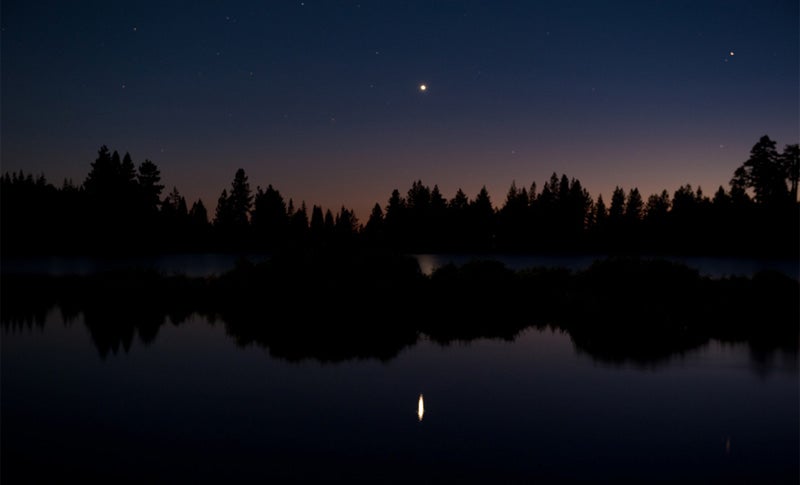A perfect pair for Valentine’s Day
ListenHead out of doors in the evening on Valentine’s Day to observe “a perfect pair” — Venus and Mars in the west right after sunset, Jupiter in the eastern evening sky at the same time and then Saturn in the pre-dawn sky. Today is the 44th anniversary of the return of Apollo 14, the 3rd manned mission to land on the moon. A meteorite found in the Sahara Desert in Morocco in 2011 came to us from Mars. This more than two billion year old sample contains the highest water content ever measured in a Martian meteorite indicating the existence of water at Mars millions of years ago.
February 9, 2015
[Dave Heller] Let’s extend anniversary greetings to the crew of Apollo14. Joining me in celebration is Derrick Pitts, chief astronomer at the Franklin Institute. Derrick, we’re going all the way back to 1971 — pretty heady times for NASA missions to the moon.
[Derrick Pitts] Indeed it was, this was the third mission to land on the surface of the moon. The crew for this misson was Stuart Roosa, Edgar Mitchell and Alan Shephard.
Ah, that’s a name I recall from even earlier NASA missions.
Indeed you should because Alan Shephard was one of the original seven Mercury astronauts. He did, of course, travel in space as a Mercury astronaut, but he was the only one of the original seven to actually reach the moon, to walk on the surface of the moon. And his crew members in addition — Ed Mitchell and Stu Russa — that particular mission, Apollo14, was their only space mission. So Stu Russa got close but he remained on board the command modual, orbiting the moon, while Mitchell and Shephard were down on the surface of the moon collecting rocks. They spent two days on the surface; missions after this spent more time on the surface of the moon and ranged much farther away from the lander.
Yeah, that’s true. These first three missions, the astronauts upon their return were required to go into two week quarantine to make sure they aren’t bringing back any organisms from the moon that could be contagious or cause any sort of problems. So this was the last one of those. After that, once the astronauts came back and went through a physical, they didn’t have to go through the quarantine part any more.
Indeed you should because Alan Shephard was one of the original seven Mercury astronauts. He did, of course, travel in space as a Mercury astronaut, but he was the only one of the original seven to actually reach the moon, to walk on the surface of the moon. And his crew members in addition — Ed Mitchell and Stu Russa — that particular mission, Apollo14, was their only space mission. So Stu Russa got close but he remained on board the command modual, orbiting the moon, while Mitchell and Shephard were down on the surface of the moon collecting rocks. They spent two days on the surface; missions after this spent more time on the surface of the moon and ranged much farther away from the lander.
-

In this image provided by NASA, Apollo 14 Mission Commander Alan Shepard Jr., second from right, leads fellow astronauts Edgar Mitchell, center, and Stuart Roosa (wearing Converse Chuck Taylor’s) into the Mobile Quarantine Facility aboard the USS New Orleans following their recovery, Feb. 9, 1971. (AP Photo/NASA)
Gosh, 44 years ago and there might be another decade or so before we even seriously get back to the moon and/or Mars. I understand you had the opportunity to speak an illustrious astronaut that made that trip to the moon.
Oh yes I did. Last week at the world affairs councils meetings here in Philadelphia for a program about the future, I spent a few hours with Buzz Aldrin as part of a panel discussing the future exploration of space. And of course the typical questions were — is it really worth doing this? And also, do you think we’ll get back into space? Colonel Aldrin’s approach to this is actually quite stunning in that he strongly believes that not only should we back in space with crewed missions but he believes that the target we should be aiming for immediately is Mars. Now we shouldn’t be waiting to go back to the moon as an end-all-and-be-all of space exploration for humans, but that we should go to Mars.
How does he build his argument for that?
He feels that going back to the moon is just chasing old glory, as opposed to going on to make new discoveries by going onto Mars.
Certainly the most drama, but the most science as well?
Aldrin believes that we have most of the technology already available to us, and we have the ingenuity to build out everything else we need to make these trips realistic. So he thinks we should actually target for that beginning now and that we should actually push for that directly, perhaps using the moon as a staging position but not as a final destination.
-

Apollo 11 astronaut Buzz Aldrin. (AP Photo/Steven Senne)
Quick refresher: The moon is, what, a quarter million miles away, it took a few days to get there. What’s a trip to Mars look like?
For the shortest overall trip, six months out, you could spend up to a month on the surface, and then you’d have to come right back. Otherwise, the two planets start to fall out of alignment with eachother, the distance becomes greater and it costs a lot more in fuel to chase after Earth and catch up to Earth. So if you actually wanted to spend some serious time there, you’d have to wait until the planets come back into alignment — another year or two years later. And now your mission stretches out to more than 18 months to 2 years.
Of course we don’t have to wait for an expedition to Mars to bring back some Martian rocks. Apparently a once-meteorite and now Martian meteorite is right here.
When you analyze all of the chemicals in it, you find that the proportions of different kinds of minerals in this rock match those in studies of Martian rocks done by the Martian rovers that are there now.
What kind of cataclysmic event compelled it to dislodge from Mars and head out way?
Boy, what a great story that must have been to be able to follow that along. But what we can deduce — and what I like to call forensic astronomy — is that when we look at this chunk of meteorite, we find that we find these pieces that are broken up pieces of crust. Well at some point in the history of Mars, some cataclysmic event like an impact from another asteroid or meteorite broke up these pieces of Martian crust, melted the material around them, or in some kind of volcanic environment put them together as little chunks and flecks in this background piece of basalt, but then eventually was blasted off of the surface by perhaps another impact that then sent this chunk into orbit around the sun that eventually came across the orbital path of Earth. And then this meteor then fell to the Earth, becoming a meteorite.
As the Mars rovers are now looking for evidence of water, can that be found on this tiny sample?
Oh, what an amazing find to discover that not only are there a number of different kinds of Earth-like minerals that are part of this rock, — pyroxeres, magnetite — all sort of different sort of normal Earth minerals. We also find that this particular meteorite sample shows us the highest percentage of water in a Martian meteorite ever seen before. So it gives us a really good indication that at some time in the history of Mars, there certainly was a lot more water on the surface involved in the geological processes of Mars.
We have a moment left: Can we look to Mars in the night sky this week?
The really cool thing about planet viewing this, Dave, is that if we wait until Saturday, Valentines Day, we find the perfect matching pair for Valentines day over in the southwestern sky right after sunset. It’s Venus and Mars. Perfect pair, just for Valentine’s Day. But, if that’s not enough, you can also look over to the eastern side of the sky about the same time where you’ll find Jupiter way up in the eastern side of the sky. For those who are up early in the morning, over in the east before sunrise you’ll find the ringed planet Saturn, although you’ll need binoculars or a telescope to see the rings.
-

Photo by Flickr user Justin Kern
WHYY is your source for fact-based, in-depth journalism and information. As a nonprofit organization, we rely on financial support from readers like you. Please give today.




